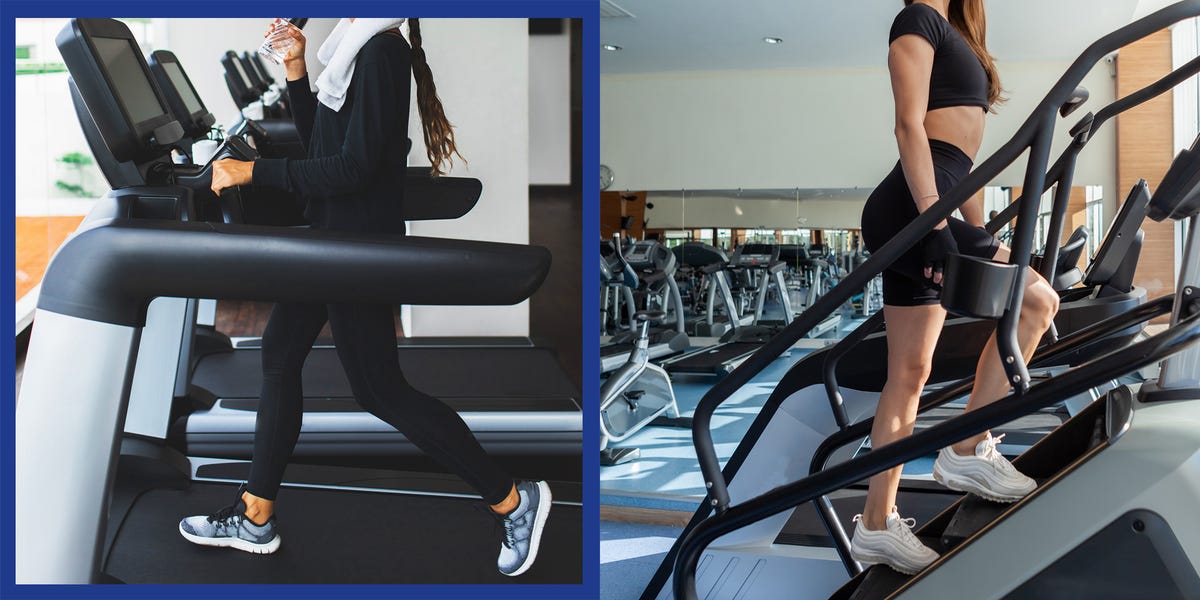You have choices every time you hit the gym, and the right decision at that moment ultimately comes down to the type of results you’re after. If you’re looking to do a cardio machine workout that gives you maximum burn, toning, and endurance with minimal time, you might narrow things down to two common training options: walking on an incline or stair climbing.
But there’s a lot to consider when mulling over the choice of incline walking on the treadmill vs. using the stair stepper. While there’s some overlap in benefits, and the movement patterns seem similar, these are two very different modalities with distinct perks.
With that, it’s important to drill down on your goals. Do you care more about calorie burn, muscle engagement, or cardio endurance—or do you ultimately want some level of them all?
Here’s what incline walking on the treadmill has to offer compared to the stair stepper, according to fitness experts. Given that variety is important with exercise, we also tapped our experts for information on how to get the most out of each machine.
Meet the experts: Alexander Rothstein, EdD, exercise physiologist and program coordinator of Exercise Science at New York Institute of Technology; Catherine Jarrett, PhD, RDN, a registered dietitian and exercise physiologist at Washington State University; Albert Matheny, RD, CSCS, a registered dietitian, strength coach, and co-founder of SoHo Strength Lab.
What These Machines Actually Do
The biomechanics—meaning, how your muscles, bones, tendons, and ligaments work together when you use each piece of equipment—have some unique distinctions depending on the equipment.
Your Body On Incline Treadmill Walking
“Traditional walking on a treadmill is an easy task but, once you add that incline, you now have to work against gravity to propel yourself upwards,” says Alexander Rothstein, EdD, exercise physiologist and program coordinator of Exercise Science at New York Institute of Technology. “That’s considered a much harder task compared to just walking.”
When you walk on an incline, you need to shift your center of gravity forward to be able to keep your balance. “You end up changing your body position slightly,” Rothstein says. “You lean forward from the ankle, but sometimes the hips and back.”
Walking on an incline activates your calves, glutes, and hamstrings, especially if you’re moving at a faster pace, says Rothstein.
Your Body On The Stair Stepper
“You’ll find that you’re engaging similar muscle groups with the stair stepper,” says Catherine Jarrett, PhD, RDN, exercise physiologist at Washington State University. However, Rothstein notes that you need to lift your knees higher on the stair stepper, which is a larger hip motion than just walking forward.
“The same component of having to press down into the ground is still happening [with a stair stepper],” Rothstein says. “You definitely still use your calves, but not as much.” He also says you may use your glutes and hamstrings more with the stair stepper from the pushing-down motion required to propel yourself up with each step.
Of course, each machine can be adjusted to meet a range of fitness levels. For incline walking, that can mean moving the incline up and down, along with adjusting the speed; For the stair stepper, it means tweaking the speed.
Which one burns more calories?
It’s important to kick this answer off with a big caveat: A ton of factors influence how many calories you burn on each cardio machine.
“Intensity is a big one, along with your speed, incline, and body weight,” Jarrett says. “If you weigh more, there’s more gravity on your body and you’ll burn more calories.”
Your fitness level at baseline can also be a factor. “Someone who is more fit may burn slightly fewer calories because their bodies are more efficient and they’re more aerobically fit,” Jarrett says. That means, if you’re already in solid shape, you may need to do a higher incline or faster pace than someone who isn’t as fit as you to get the same calorie burn.
All of that said, in general, a 150-pound person may burn anywhere from 200 to 300 calories in 30 minutes on the stair climber, Jarrett says. The same is true for a treadmill on an incline, she says. “But a lot depends on your individual fitness level and pace,” Jarrett reminds.
According to the American Council on Exercise’s fitness calculator, a 150-pound person will usually burn about 272 calories climbing stairs for 30 minutes, while that same person would burn about 170 calories walking at a “very brisk” pace of 4 miles per hour (that doesn’t factor in an incline, though, so with that, the level of calorie burning is definitely higher).
That said, the stair stepper is usually a bigger calorie burn when you compare it directly to a treadmill. “More people struggle with the stair stepper because, if it was moving at the same speed as a treadmill, the act of having to lift your leg the full distance is technically harder,” Rothstein says.
Which one is a better cardio workout?
This comes down to the intensity of your workout. “If someone were to, say, walk on a higher incline or speed versus the stair stepper, it could be more intense on the treadmill,” Rothstein says. “But you could reverse that if someone goes up more stairs.”
There’s one more thing to consider, per Jarrett: How likely you are to stick with each workout. “The type of exercise you’ll get the most out of is the one you’ll continue to do,” she says. “When it comes to cardiovascular health, it’s about what you’ll do consistently.”
Still, the stair stepper tends to challenge people a lot very quickly, putting exercisers quickly into a higher VO2 max, which measures how well your body uses oxygen during exercise, Rothstein points out.
“If you had to match them one-to-one, the stair stepper has a higher demand,” on the cardiovascular system, he says.
Which one is a better strength workout?
The stair stepper may also be better for strength workouts, says Albert Matheny, RD, CSCS, co-founder of SoHo Strength Lab. “You’re recruiting more of your quads and glutes when you’re lifting your whole body up vertically,” he says. (However, Matheny points out that you can increase the incline on the treadmill to make you lift your knees up more.)
That doesn’t mean that incline walking is bad for strength training, though. “But muscle recruitment is higher in the stair stepper,” Matheny says.
Something else to consider, just in case you’re dealing with physical limitations or aches: Incline walking may be gentler on your joints. When researchers had a small group of volunteers walk on a treadmill at different inclines, they found that walking on an elevation put less stress on the knee joint while still strengthening muscles in the legs, per the study in Gait & Posture. Another study in Sports Medicine and Health Science found that walking on an incline lowered knee pain and increased strength in older adults who walked on an incline of at least 10 percent.
It’s worth noting, though, that there isn’t research that compares these exercises head-to-head and that the stair stepper is also considered a low-impact workout. Meaning? You really can’t go wrong with either one.
Tips For Getting The Most Out Of Each Machine
No matter which machine you choose, experts say there are a few form checks and other reminders that can help you maximize your workout.
On the treadmill…
- Don’t hang on the railings. “When you do this, you almost remove the benefit of this exercise,” Rothstein says. Essentially, by relying on the railings, you shift some of your weight off of your lower body and core, which are the main muscles the treadmill is supposed to target. Instead of walking or running under your own strength, you’re creating a crutch that reduces the intensity and effort of the movement.
- Make sure you can use your arms. You should be able to swing your arms while you walk, Matheny says. Your arms play a key role in maintaining balance and helping you power through your stride. If you can’t, or you find yourself grabbing for that handrail often, it’s a sign that the incline or speed might be too high. Back off the incline, speed, or both.
- Challenge yourself as you go. Rothstein suggests doing a 20- to 30-minute workout and increasing the incline or speed every minute to create more of a challenge. Think of it as a way to level up each minute—start easy and build the intensity as you go.
- Do intervals. That can mean increasing the speed and/or incline for a period of time, like a minute, before reducing it and repeating this again in a minute, Matheny says.
On the stair stepper…
- Don’t hunch over the handrail or hang onto it. “I can’t stress this enough,” Rothstein says. Doing this lessens the impact of your workout, he says. When you lean heavily on the handrail, you offload your body weight and reduce the engagement of key muscle groups like your glutes and quads. Plus, it can mess with your posture, making you more prone to discomfort or injury.
- Try interval workouts. While you’re just fine to step at a steady pace, doing intervals of moving at faster and slower clips can help to challenge you more and keep you more engaged in your workout, Matheny says. Think of it as spicing up your session to avoid zoning out.
- Consider a weighted vest. If you feel comfortable and challenged by using a stair stepper under normal circumstances, adding weights can help increase the intensity. “Add a weighted vest,” Matheny says. “I wouldn’t recommend holding anything in your hands for safety reasons.” WH editors love the Empower Vest because evenly distributes the weight so you can still focus on proper form without the risk of losing balance.
- Maintain good posture. Try to keep your back straight as you climb. Poor posture raises the risk of an injury, Rothstein says.
While narrowing down which workout will give you the most results when you’re pressed for time, experts recommend rotating between both forms of exercise, if you can. That can mean doing something like spending 15 minutes on each machine during one workout. “Having both in your toolkit is helpful,” Rothstein says. “It’s almost like cross-training.”
Korin Miller is a freelance writer specializing in general wellness, sexual health and relationships, and lifestyle trends, with work appearing in Men’s Health, Women’s Health, Self, Glamour, and more. She has a master’s degree from American University, lives by the beach, and hopes to own a teacup pig and taco truck one day.
Read the full article here




